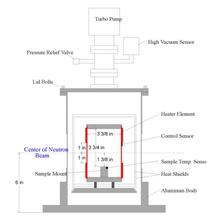The Brookhaven National Lab (BNL) Furnace is primarily a vacuum furnace; nevertheless, it can also be reconfigured to run in air or an inert gas. The main disadvantage of running the BNL Furnace in a gas atmosphere is the maximum temperature limitation imposed by its lack of cooling. This system is more robust than the other general use furnace (F-1600C), but has a lower maximum temperature.
| Sample Geometry |
|---|
| Sample Holder |
Multiple Copper Posts (see below) |
| Sample Access In Plane |
350o |
| Sample Access Out of Plane |
+20o |
| Maximum Sample Diameter |
7.6 cm (3.0 inches) |
| Maximum Sample Height |
3.5 cm (8.9 cm) |
|
|
General Description
Sample Preparation
Experiment Planning
-
- Sample visibility of 350o in scattering plane, 20o out of plane
- Irradiative heating via a cylindrical element driven by a high voltage AC power
- Active Heating/Sample Zone : 6.5 cm diameter x 8.5 cm length
- Interlocked alarm system for pressure, and temperature
- Pressure relief valve rated to 10 psi has been installed in the system
- Sample Temperature Stability: +1oC at 600oC
- Sample Holders: A user designed (NIST assistance is available) sample holder compatible with our probes is required. There are two possible sample mounts: A 3/8" diameter copper post with either a 1/4-20 female thread or a M4-0.7 male thread; and a copper base designed to fit our single-crystal sample cans. Ventilated (i.e. non-pressure building) crucible-type holders made of niobium or platinum are ideal; however, special sample mounts can be designed. Any sealed sample holder must be tested off-line at the maximum desired temperature before loading into the furnace to ensure that an over-pressure burst will not occur on the beam line.
- Sample Geometry:
- Note that the beam center is 152.4 cm (6 inches) above the bottom of the furnace, and the standard mounting post height is 3.5 cm (1 3/8 inches) from the center of the beam.
- Any Cd masking MUST be done on the outside of the furnace
- Plan ahead. At a minimum it will take 2 hours for the sample to reach 600oC.
- Leave time at the end of the experiment to allow the sample cell to cool in order to open the vessel.
- Design the experiment with proper sample mounting and ultimate sample temperature requirements in mind.


